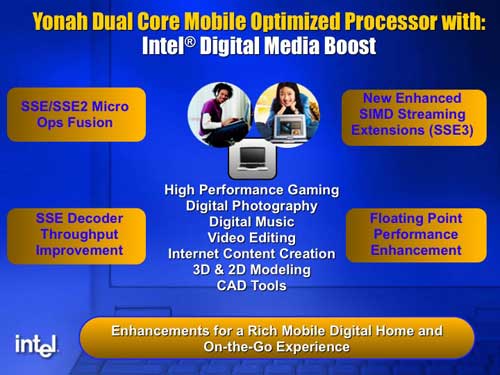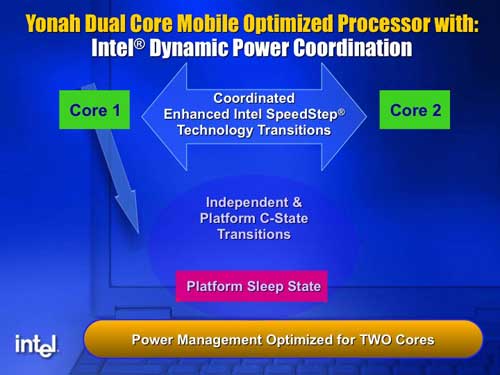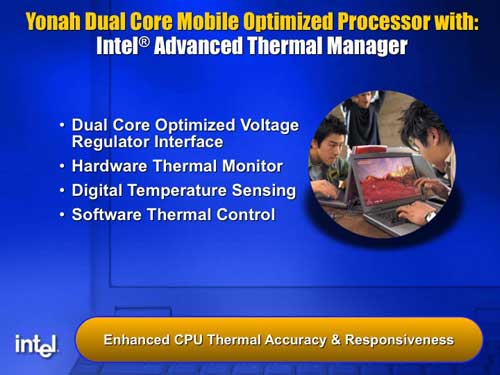
Original Link: https://www.anandtech.com/show/1915
Intel's Core Duo Launch - Notebook Performance Revealed
by Anand Lal Shimpi on January 5, 2006 8:00 PM EST- Posted in
- Laptops
It seems almost anti-climactic, given how much we’ve seen of Intel’s new Centrino platform and not to mention that we’ve already been able to benchmark the new Core Duo CPU. Believe it or not, despite the months of leaks of new logos and pre-NDA benchmarks, today is the official launch of Intel’s Centrino Duo platform. Or another way of looking at it: today is Yonah’s public birthday.
We were so excited about Yonah when we first heard about it, but now that we already know so much is there anything more worth talking about? And is there even anything more worth getting excited about? We already know it’s going to be called the Core Duo, we already know about Intel’s Leap ahead slogan and we’ve heard the word platform from Intel more times in the past year than we’ve heard in the past decade. Is this even an article worth doing?
As if you didn’t already know the answer to that rhetorical question, we should at least point out one thing. In our previous articles we looked at Yonah very similar to a fish out of water, we compared a very fast, very cool running, low power mobile processor to a bunch of desktop alternatives. We used it to give us a clue into future desktop performance from Intel, but it was what we didn’t do that makes this article today so very important. What we didn’t do with Yonah was stick it in a notebook and see how it fares in its natural habitat. And that’s what we’re here for today.
Today’s article is very much a look at Yonah and Centrino Duo as they were intended to be viewed - as members of a mobile society. The primary point of comparison here today will be Dothan and the previous generation Centrino. While we would like to compare to AMD’s Turion 64, we only had a very limited time with the notebooks in this review and we could not get a Turion 64 notebook given the short notice and time constraints. The other point worth mentioning is that the Turion 64 vs. Yonah comparison will be a lot more fair and make a lot more sense when AMD releases their dual core Turion later this quarter.
As we mentioned above, not only is today the official launch of Intel’s Centrino Duo platform, it is the official unveiling of Intel’s new logo and slogan - Leap ahead.
We’ll save all criticisms of the Viiv brand and Leap ahead for you the readers, but here are the new logos:
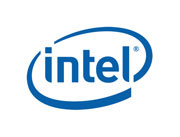

And for old time's sake, here's the old logo in use:
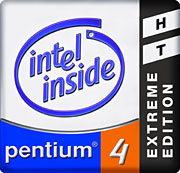
The new slogan is supposed to signify Intel’s shift away from focusing “inside” and starting to look at platforms and solutions for the end users.
With that out of the way, it’s time to look at what Intel’s Israel team has been working on for the past couple of years.
The new Centrino
When Intel introduced their Centrino brand and announced that they were shifting to more platform-centric marketing, it made the job of the consumer a lot easier. Instead of worrying about silly things like processor names and specifications, you could just walk into a store and ask for a Centrino notebook and you’d be guaranteed that you’d get something decent. At the same time, Intel’s efforts have made our job a little more difficult because we focus on much more than just the overall brand. We’re of course interested in the individual components that make up the brand, but that means that we now have to talk about individual product code names, as well as brand code names. Keep that in mind, and be patient with us, as we take you though all of the parts of the new Centrino.
The new Centrino brand being announced today is Intel’s Centrino Duo brand. As has been the case since the introduction of Centrino, in order for a manufacturer to call their notebook a Centrino it has to meet three very specific requirements. The CPU, chipset and wireless adapter must all be provided by Intel. It gets a little more specific than that of course, since Intel usually tells the manufacturer exactly what chipset and what wireless adapter they must use from Intel’s line as well. If you follow all of Intel’s instructions and buy the right components, you get access to some of Intel’s Centrino marketing funds and you get the right to use the Centrino name on your laptop. Since the original introduction of Centrino we’ve basically seen manufacturers offer both Centrino and non-Centrino versions of their notebooks and we expect that to continue with the Centrino Duo platform.
So what does Intel require of manufacturers to be Centrino Duo certified? The notebook manufacturer must use an:
1) Intel Core Duo microprocessor
2) Intel 945 Express Chipset
3) Intel 3945ABG Wireless solution
If all three requirements are met, then the notebook is officially a Centrino Duo. And here is where those code names start cropping up. The Core Duo microprocessor is nothing more than the dual core Yonah we’ve been talking about for quite a while now; and the 945 Express chipset should sound very familiar as it is a mobile version of the 945 chipset that was released on the desktop side last year.
Now the combination of the Core Duo processor, 945 Express chipset and the 3945ABG wireless solution is what is known as the Napa platform. In other words, the code name for Centrino Duo is Napa. Its predecessor is Sonoma, which is the code name for the Centrino platform that was composed of Intel’s Pentium M (based on Dothan), 915 chipset and 2915ABG wireless solution. We will refer to Napa and Sonoma later in this article, so just keep in mind that Napa is the current Centrino Duo while Sonoma is the previous generation Centrino based on Dothan.
Napa vs. Sonoma - Tangible Features
While the most exciting element of today’s launch is Intel’s Core Duo microprocessor, there are some other benefits that Napa provides us with over Sonoma. As far as we can tell, the majority of the tangible non-CPU performance improvements are actually contained within the Intel 945 Express chipset.
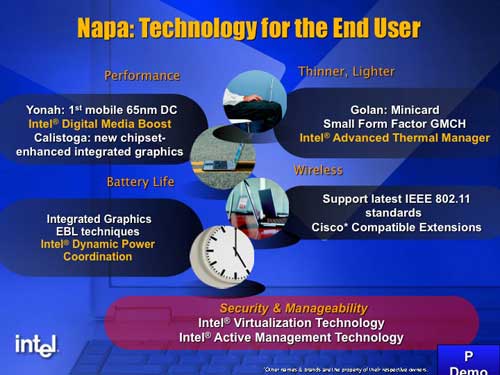
Napa bumps up the FSB frequency from 533MHz in Sonoma to 667MHz, giving the Core Duo a 25% increase in FSB bandwidth over its predecessor. Given that there are now two cores being fed by the same FSB, an increase in FSB bandwidth is necessary and appreciated. However unlike on desktop platforms, Intel can’t just increase FSB frequency like mad simply because higher bus frequencies mean greater power consumption, or lower battery life. Napa could have probably benefitted from a faster FSB, but the upgrade will probably have to wait until a later date.
Along with a faster FSB, the 945 Express chipset brings DDR2-667 support to the table. We have seen manufacturers continue to use DDR2-533 as well as shift over to DDR2-667, so just because the support is there don’t expect everyone to take advantage of it. The truth of the matter is that even with DDR2-533, since the platform is dual channel, there is already enough memory bandwidth to feed the 667MHz FSB. The only thing DDR2-667 brings to the table is better performance for integrated graphics and lower latency memory accesses as it runs synchronous with the 667MHz Napa FSB.
Other than the faster FSB and memory bus, Napa’s remaining features outside of the Core Duo processor are predominantly power related.
A Lower Power Chipset
One claim that Intel has been making for quite some time is that Centrino Duo will offer better performance at lower power consumption than the previous generation Centrino platforms. While we will investigate that claim with performance and battery life tests later on in this article, it’s important to look at the building blocks that would support such a claim.
As we found with the original Centrino platform, reducing the power consumption of the CPU is only part of the equation. The FSB, chipset and wireless controller all contribute to power consumption in the system and they all have to be addressed individually in order to truly increase battery life on notebooks.
The FSB issue was originally addressed with the first Centrino platform, which ensured that the IO buffers on the FSB interface were initially in an off state until eventually woken up before data could be sent over the bus. The downside to this approach was that there was an additional latency penalty incurred while waiting for the buffers to wake up, but the benefits were reduced overall power consumption.
The chipset and wireless solutions have both been undergoing reductions in power consumption over the past couple of years. Most recently, the Sonoma platform used in the last generation Centrino offered lower power consumption than the original platform, and of course Intel is promising the same today with the Napa platform used in Centrino Duo notebooks.
The 945 Express chipset is still built on a 130nm process (just like the 915 used in Sonoma), but promises lower power consumption for two basic reasons. The ICH7M used in the 945 Express chipset is a lower voltage redesign of ICH6 used in Sonoma. A lower voltage design itself may not necessarily reduce power consumption, but the new ICH also incorporates more aggressive clock gating (turning off the clock supplied to various blocks of the ICH when not in use) and IO buffer gating (turning off the IO buffers when not in use) to achieve lower power usage.
The second force at play to reduce the chipset’s power consumption is what Intel is referring to as “aggressive design enhancements” on PCIe blocks. Intel couldn’t go into detail here but we’re guessing that they are talking about slight design changes to reduce power consumption in their PCIe controllers on the chipset. The impact of these changes won’t be huge, but it should contribute to an overall reduction in power. Once again, although not going into great detail, Intel did mention that they were able to reduce power in many of their analog circuits as well - most likely through careful investigation and redesign of power hungry elements of the chipset.
We have heard of overall power reductions of as much as 3W thanks to the chipset optimizations mentioned here. While it’s difficult to isolate just the chipset and measure the power consumption ourselves, at least we can be somewhat confident that there is no increase in power consumption of the new platform. Later this year, Intel will migrate their chipsets down to 90nm which should allow for even greater reductions in power consumption.
Core Duo - A High Level Architectural Overview
We have talked extensively about Intel’s Core Duo processor since back when it was called Yonah, and while we would have liked to bring you an extremely detailed report on exactly what was done (architecturally) in Yonah to make it what it is today the fact of the matter is that Intel just isn’t very forthcoming with this sort of information.
Intel has been very protective with their Centrino processor architectures ever since the platform’s introduction. We’ve always been given bits and pieces of information, but never the full disclosure we’ve hoped for. Even to this day Intel has not disclosed the exact number of pipeline stages in the Pentium M or Core Duo processors. In many cases it was Intel’s first Pentium M processor, Banias, that they were most forthcoming with. With every successor, the flow of information became far more marketing and far less technical. We do hope that at some point this won’t be the case, but until then we will have to do the best with what we’re given at this point. What follows is a brief architectural overview of Intel’s Core Duo to help you understand where some of the performance advantages and more importantly, improvements in power consumption, come from at an architectural level.
Intel’s Smart Cache
The very first thing you can take for granted about the Core Duo processor is that all of the advancements in performance and power efficiency seen in previous Pentium M processors are all rolled into the Core Duo. That means the power saving cache in Banias and Dothan is still here today, as is the unique method of architecting the CPU for a fixed clock frequency rather than maximum performance.
If you take for granted the years of work that Intel’s Israel team put into Banias and Dothan (which I’m sure they would love for you to do), it makes understanding the improvements of Core Duo all that much easier.
While it’s easy to assume that the biggest change in Yonah is the fact that it is a dual core processor, the largest impacts actually come from how those two cores interact and not the fact that there are two of them to begin with. One such example is what Intel is calling their “Smart Cache”, which is just a really terrible way of saying that the two cores share a common 2MB L2 cache.
In AMD’s Athlon 64 X2 design there is a System Request Queue (SRQ) that queues up memory requests from each core and sends the requests off to either main memory or one of the on-die caches.
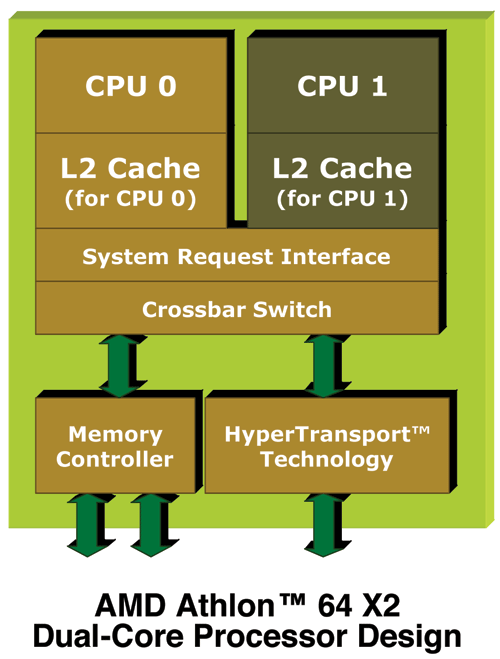
How core-to-core communication works on the Athlon 64 X2
The beauty of the SRQ is that the two cores can communicate with one another at core speed. This is in stark contrast to the way the Pentium D works, where all cache-to-cache requests must actually leave one core, go out onto the external bus before finally being sent to the other core.
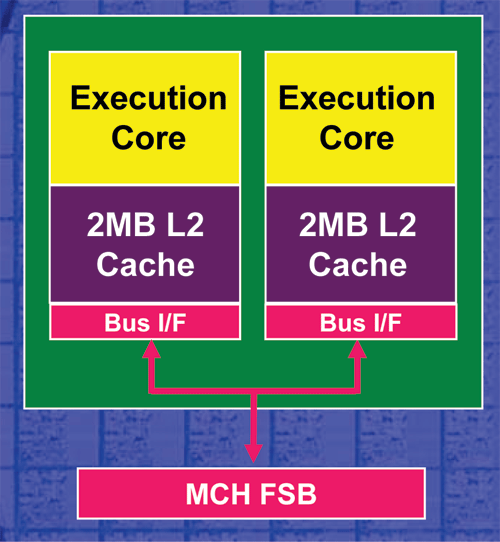
How core-to-core communication works on the Pentium D
Why do you need to communicate between two cores? If both cores are working on the same data, they must be in communication to determine which cache actually contains the latest and most correct copy of the data before using it (either for further operations or for writing it to main memory). In order to ensure that only one core has the “correct” copy of the data, the individual cores may put requests on the bus (or SRQ in the case of the Athlon 64 X2) asking to invalidate the copy of the data that should not be used. This sort of traffic does take up bus bandwidth and is much better handled on-die than over a higher latency external bus.
With a shared L2 cache, core-to-core communication can happen much faster than on the Pentium D, since it runs at clock speed - making the Core Duo a lot more like the Athlon 64 X2 in that regard. It still lacks an on-die memory controller, but communication between the two cores is improved. It is worth noting that even when comparing AMD’s Athlon 64 X2 with its SRQ to Intel’s Pentium D which lacked any low latency core-to-core communication, the real world impacts in desktop applications were tough to find. That being said, we would rather have the benefit on paper and have it hard to prove in the real world than not have it at all.
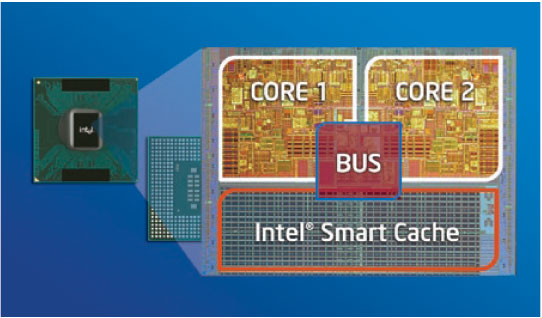
Core-to-core communication on the Core Duo
The other benefit of Intel’s Smart Cache is that it can be dynamically resized depending on the needs of the individual cores. So if one core is running idle, the other core can get full access to the 2MB L2 cache. If both are active, they are able to split the 2MB of cache depending on their needs, which means that as long as both cores wouldn’t benefit from a full 2MB cache then overall efficiency of the chip is better than a similar design with two separate 2MB caches.
Also, as the size of the L2 cache is changed its usage is also monitored. If it is determined that the cache can safely be flushed to main memory and powered down, the cache controller will do so to keep CPU power consumption down. The idea here is that refreshing main memory will eat up less power than keeping the on-die cache running and active.
Intel’s Digital Media Boost
Nothing says an increase in decoder throughput and instruction level parallelism better than Digital Media Boost, which is what the next group of Core Duo’s enhancements are called.
We’ve known about Digital Media Boost for a while now, and Intel actually publicly disclosed information about the Boost at the last IDF. Unfortunately since then there has been no new information, so all we can report on is what we’ve already talked about:
Making Pentium M more "Media Friendly"
All of the major performance improvements to each of Yonah's cores seem to revolve around SIMD FP and FP performance, two of the Pentium M's present day weaknesses in comparison to the Pentium 4.
The first improvement is that now all three of Yonah's decoders can decode SSE instructions, regardless of the type of instruction. Improving the decode width of the processor is a quick way to improve performance.
Next, SSE/SSE2 operations (not sure if all can be, but at least some) can now be fused using the Micro Ops Fusion engine of Yonah. At a high level, the benefit here is increased performance and lower power consumption, we'll get into architectural details of why that is when we eventually sink our teeth into Yonah next year.
Each of the two cores in Yonah have also received support for SSE3 instructions much like the Pentium 4 E [Prescott].
And finally there have been some improvements to Yonah's floating point performance, although Mooly would not say exactly what's been done. Curiously, Mooly referred to the floating point performance improvements as specifically made to improve gaming performance. Intel may have grander plans for Yonah than once thought...
The SSE/FP optimizations are all being grouped into what Intel is calling their Digital Media Boost technology, yes the names seem to get worse and worse as time goes on - but at least the functionality should be good.
CPU-Level Power and Thermal Enhancements
Back in March Intel's Mooly Eden told us that despite the move to two cores and almost doubling the transistor count of Dothan, Yonah notebooks would offer battery life no shorter than Dothan notebooks. In other words, you'd get all of the performance benefits of dual core but with no power consumption penalty.
While we noted that, at least on the desktop side, both the Athlon 64 X2 and Pentium D provided us with dual core performance but with only an additional 15% increase in power consumption. So it wasn't too far fetched to believe that, with enough effort, you could move to dual core, increase performance and not increase power consumption.
At the same briefing where they told us that they would keep power consumption the same, Intel also told us how they'd do it:
From the first time we heard the name Yonah we knew that its designers would be introducing some interesting power management technologies. While we don't normally like filling articles with quotes, here's one from Mooly today that is a great segue into this section:
"Yonah battery life will not be shorter than Dothan battery life...[it's] a huge achievement"
Given that Yonah will have twice the decode/execution transistors of Dothan, offering equal battery life for Yonah notebooks is a pretty impressive claim.
Mooly went through some of the power management technologies in Yonah that Intel is calling Dynamic Power Coordination. The idea is this - there are some areas where you can have each core operate independently with regards to reducing power consumption, but other areas where you can't.
Dothan has five operating states:
C0 - full power
C1 - auto halt (less power)
C2 - stop clock (even lower power)
C3 - sleep (lower power)
C4 - deep sleep (still lower)The CPU's goal is to complete the tasks it's given, while always striving to be in as low of a power state as possible. So for example, if a Dothan is running an application that doesn't require full performance, it can operate in one of the lighter power saving states until it is done working, then eventually drop all the way down to C4.
The lighter power saving stages just do things like reduce clock speed or gate the clocks to parts of the chip, these types of things can be done independently on each core in Yonah (e.g. one core can be in C1 while the other core is in C0). Once you get down to adjusting voltage and playing with the PLL, then the two cores can't act independently - since they are both fed the same voltage and clock signal. Here is where Intel's Dynamic Power Coordination comes into play; if one CPU wants to go to a lower power state (e.g. C3 or C4) but the other core is running at C0, it will inform Intel's DPC logic of the current situation. Intel's logic, as you would expect it to act, will wait until the core running in C0 is done working and then move both cores down to the lower power state. Synchronization like this is important and it helps keep power consumption down to a minimum.
Because of the power management that is needed for Yonah, the two cores have to always work closely together to make sure that they are aware of each other's power state desires - for this reason alone Yonah is already much more than a pair of Dothans with a shared cache.
Yonah also introduces finer grained thermal management through what they are calling the Advanced Thermal Manager. With dedicated digital thermal sensors in each core, each with a higher accuracy, the temperature data the CPU can feed the rest of the system is more accurate in Yonah than in previous generation Pentium M CPUs. Although Mooly didn't talk about it here, you can expect that the thermal management technology in Yonah will allow for one core to be slowed down independently of the other if power consumption or heat dissipation rises too much.
The one item that isn't mentioned, but is quite responsible for the excellent thermal and power characteristics of Intel's Core Duo is the 65nm manufacturing process it is built on.
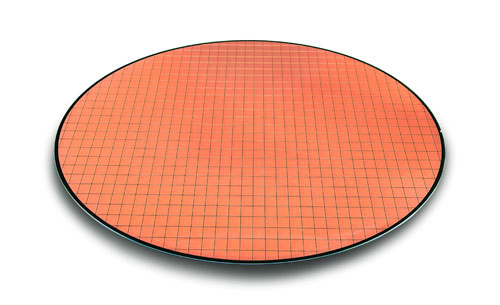
A Yonah wafer
Intel's 65nm process is ramping up nicely and is extremely cool running and very low power. Combine it with the power management technologies talked about above and you can see how the move from Dothan to Yonah wouldn't negatively impact power consumption.
Intel Core Duo - Model Numbers and Clock Speeds
The Core Duo is launching at four speeds as well as in a low voltage variety. Once more, Intel has changed their naming system for processors, this time they've settled on a 5 character model number with the first letter denoting power consumption and the remaining four digits indicating performance. For example, the highest end Core Duo processor being announced today is the T2600 which runs at 2.16GHz. The fastest low voltage Core Duo is the L2400, but it only runs at 1.66GHz.
A complete rundown of the new CPUs, model numbers and clock speeds is listed below:
| CPU Name | Clock Speed | Pricing (with 945GM chipset and wireless solution) |
| Intel Core Duo T2600 | 2.16GHz | $706 |
| Intel Core Duo T2500 | 2.00GHz | $492 |
| Intel Core Duo T2400 | 1.83GHz | $363 |
| Intel Core Duo T2300 | 1.66GHz | $310 |
| Intel Core Solo T1300* | 1.66GHz | $278 |
| Intel Core Duo L2400 | 1.66GHz | $385 |
| Intel Core Duo L2300 | 1.50GHz | $353 |
*Note: The Core Solo processor is a single core version of Yonah.
Real World Centrino Duo Performance
We’ve already run the full gamut of performance benchmarks on Intel’s Core Duo processor, however those performance tests compared Intel’s latest mobile processor against some of the strongest desktop competitors. What our performance tests here will show is how well the Core Duo competes in the mobile space, or more specifically, how it stacks up to the Pentium M in a notebook.
To assist with our little performance experiment we turned to ASUS, who just happens to know a thing or two about notebooks. You see, ASUS not only has an extensive line of their own notebooks that they manufacture under the ASUS brand, but they also happen to make notebooks for companies like Apple and Dell. So when we asked for two identical notebooks one based on the latest Napa platform and the other based on the previous generation Sonoma platform, ASUS was well equipped to respond.
What they provided us with was two notebooks from their W5 line, which is a line of extremely portable sub-3 pound 12.1” widescreen notebooks. The two models that ASUS provided were the W5F and the W5A.

The ASUS W5F and W5A - can you tell the difference?
The beauty of the W5F and W5A is that they are virtually identical, with the only real difference being that the former is based on the Napa platform while the latter is a Sonoma notebook. ASUS even went one step further and shipped us notebooks with processors clocked identically - the W5F featured a Core Duo T2400 (1.83GHz) while the W5A featured a Pentium M 750 (1.83GHz).
What we wanted was an apples to apples comparison of Napa vs. Sonoma, and ASUS gave us the exact tools to do just that.
So without further ado, we bring you a continuation of our performance investigation of Intel’s Core Duo microprocessor - this time, in a notebook.
The Test
Both the ASUS W5F and W5A were configured identically, with 512MB of DDR2-533 memory, 80GB hard drives and both relied on their Intel integrated graphics. The only difference was that the W5F was based on Intel's Napa platform while the W5A was Sonoma based. Both CPUs operated at 1.86GHz, with the Napa platform using a Core Duo processor and the Sonoma platform using a Pentium M processor.
For all tests, each machine was tested with a clean install of Windows and all drivers installed (the latest available as of the publication date), but none of the bundled applications were installed (with the exception of any battery/power management utilities).
All performance tests were conducted with the Power Management settings set to Always On.
All benchmarks were conducted with the display set to the native resolution of the notebook's LCD panel.
Mobile Mark 2005 battery life tests were conducted with the Power Management settings set to Portable/Laptop, but with the screen set to never turn off and with the hard disk set to power down after 5 minutes. All battery life tests were conducted with the displays set to 60 - 70 nits.
Performance testing was done using Business and Multimedia Content Creation Winstone 2004, as well as SYSMark 2004.
Battery life testing was done using Mobile Mark 2005.
Business Performance
Business Winstone 2004
Business Winstone 2004 tests the following applications in various usage scenarios:
. Microsoft Access 2002
. Microsoft Excel 2002
. Microsoft FrontPage 2002
. Microsoft Outlook 2002
. Microsoft PowerPoint 2002
. Microsoft Project 2002
. Microsoft Word 2002
. Norton AntiVirus Professional Edition 2003
. WinZip 8.1

Office Productivity SYSMark 2004
SYSMark's Office Productivity suite consists of three tests, the first of which is the Communication test. The Communication test consists of the following:
"The user receives an email in Outlook 2002 that contains a collection of documents in a zip file. The user reviews his email and updates his calendar while VirusScan 7.0 scans the system. The corporate web site is viewed in Internet Explorer 6.0. Finally, Internet Explorer is used to look at samples of the web pages and documents created during the scenario."The next test is Document Creation performance:
"The user edits the document using Word 2002. He transcribes an audio file into a document using Dragon NaturallySpeaking 6. Once the document has all the necessary pieces in place, the user changes it into a portable format for easy and secure distribution using Acrobat 5.0.5. The user creates a marketing presentation in PowerPoint 2002 and adds elements to a slide show template."The final test in our Office Productivity suite is Data Analysis, which BAPCo describes as:
"The user opens a database using Access 2002 and runs some queries. A collection of documents are archived using WinZip 8.1. The queries' results are imported into a spreadsheet using Excel 2002 and are used to generate graphical charts."
The overall Office Productivity score in the three aforementioned tests is compared below:

We already know that Office Productivity performance went up tremendously with Yonah based on our desktop discussions, and the trend is no different here when looking at notebooks. The Centrino Duo system manages to outperform the identically clocked Centrino notebook by just under 30%.
Internet Content Creation Performance
MCC Winstone 2004
Multimedia Content Creation Winstone 2004 tests the following applications in various usage scenarios:
. Adobe® Photoshop® 7.0.1All chips were tested with Lightwave set to spawn 4 threads.
. Adobe® Premiere® 6.50
. Macromedia® Director MX 9.0
. Macromedia® Dreamweaver MX 6.1
. Microsoft® Windows MediaTM Encoder 9 Version 9.00.00.2980
. NewTek's LightWave® 3D 7.5b
. SteinbergTM WaveLabTM 4.0f
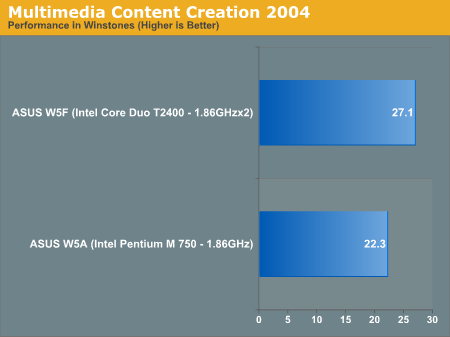
ICC SYSMark 2004
The tests that make up SYSMark's Internet Content Creation 2004 benchmark are described below. First up are the 3D Content Creation tests:
"The user renders a 3D model to a bitmap using 3ds max 5.1, while preparing web pages in Dreamweaver MX. Then the user renders a 3D animation in a vector graphics format."Followed by 2D Content Creation performance, where:
"The user uses Premiere 6.5 to create a movie from several raw input movie cuts and sound cuts and starts exporting it. While waiting on this operation, the user imports the rendered image into Photoshop 7.01, modifies it and saves the results. Once the movie is assembled, the user edits it and creates special effects using After Effects 5.5."The Internet Content Creation suite is rounded up with a Web Publishing performance test:
"The user extracts content from an archive using WinZip 8.1. Meanwhile, he uses Flash MX to open the exported 3D vector graphics file. He modifies it by including other pictures and optimizes it for faster animation. The final movie with the special effects is then compressed using Windows Media Encoder 9 series in a format that can be broadcast over broadband Internet. The web site is given the final touches in Dreamweaver MX and the system is scanned by VirusScan 7.0."
The overall performance score in all three of these tests is compared below:
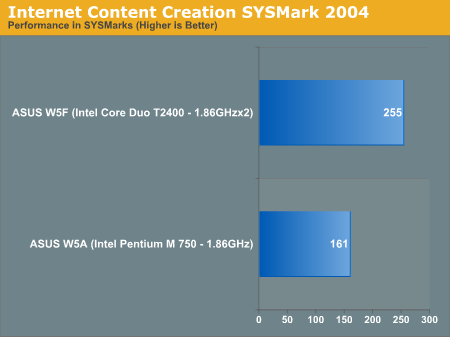
The biggest performance gains we saw on the desktop were in Internet Content Creation performance, and the situation is no different here. Let multithreading apps have their way with the Core Duo and the performance differential jumps significantly, with the Core Duo based laptop outperforming the Dothan offering by almost 60%.
Battery Life - Business Applications
While the performance of these laptops was very similar when running on AC power, unplugging them and focusing on battery life and performance changes the landscape dramatically. For our battery life tests, we turn to MobileMark 2005, which offers a total of four battery life measurement tools - the first one being the Office Productivity 2002SE benchmark.
The Office Productivity 2002SE benchmark does the following:
The workloads in this category model a mobile professional at a fictitious automobile company. The worker creates documents using Microsoft Word, Excel and PowerPoint, accesses email, and creates graphics and animation with Photoshop and Flash to include in a multimedia presentation. An Internet browser is used to view presentations. The user also invokes file compression and virus detection in the background.
Microsoft Word 2002: The user starts Microsoft Word and opens an eight-page assembly manual document for a new transmission system. The user sets paragraph formatting, font configuration and adds text to the document. The user inserts an image, a table of contents and a table of figures. Twenty additional images, ranging in size from 3 Kb to 15 Kb are inserted throughout the document. The user then adds a watermark to the document and performs a global find and replace. The document is printed and the user inserts a hyperlink into the document and adds more text. The user inserts a training video, changes the theme and saves the document in web page format. Later, the user returns to Word and opens a book to read. The user auto-summarizes the book to generate a shorter synopsis.
Microsoft Excel 2002: The user starts Microsoft Excel and opens a large spreadsheet (a 12 megabyte file with approximately 3000 rows and 248 columns of data). The user selects a group of formulae for data analysis. The user selects the data and performs a sort, using three key fields. This data is then used to create a chart, which is exported to a web page. The user then opens a different spreadsheet (an 8.5 megabyte file with approximately 2100 rows and 248 columns of data), and performs similar operations, resulting in another web page.
Microsoft PowerPoint 2002: The user starts Microsoft PowerPoint and opens a 24 slide presentation of the previous quarter's news and sales. The user moves through the presentation inserting and positioning several images (47 to 57 kilobytes in size). Upon completing this, the presentation is checked for spelling errors. The user then applies different themes/backgrounds to the presentation and selects one. Finally, the user reviews the material in slide show mode and exports the finished presentation to web page format.
Microsoft Outlook 2002: The user starts Microsoft Outlook and opens the inbox, changing the view mode to show the first lines of each message. The email editor, Word, is launched, and a document is opened, printed, and sent to an email recipient. The user then opens one of the documents in the inbox, adds a picture as an attachment, and emails it. Moving to the Draft folder, the user opens three email messages: the first has its spelling checked and is sent, the second is sent and the third is checked for spelling, summarized and sent. Three more messages are created and sent with attached images. Finally, the user compresses the Outlook offline folder.
Netscape Communicator 6.01: The user opens the Netscape browser and loads an HTML version of a Word document. The source HTML code is then viewed. The user also views two charts exported to HTML from an Excel file. Finally, the user browses through a 15-page PowerPoint slide show that was saved in HTML format.
WinZip Computing WinZip 8.0: The user creates a compressed data file from a set of bitmap files (7.6 megabytes total size) in a specific folder. The resulting .zip file is 54% of the size of the original group of files. Once started, the user moves this to the background and works with other applications.
McAfee VirusScan 5.13: The user scans program files (3,110 files and 438MB) for the presence of viruses. This is run in the background as the user works.
Adobe Photoshop 6.0.1: The user starts Adobe Photoshop and sets the workplace. A 7.12MB high-definition source file is opened and the image is sized to fit in the window. The user performs image manipulations, including Smart Blur, Distort Wave, and rotation. Finally, the user re-sizes the image and adjusts the image color levels before saving the image as a web-friendly 20kilobyte JPEG file.
Macromedia Flash 5: The user creates a Flash animation using text, graphics and still images. The user works in an existing Flash animation, adding, then manipulating and positioning a new image to appear appropriately within the final animation. To do this, the user starts Macromedia Flash and opens a preconfigured project (FLA) file, containing 23 different layers. The user moves down to one of the layers in the project file, deletes the key frame and imports a new image of a person in a kayak (a 24-bit color, 72 dpi, 300 x 211 resolution PNG format image with transparency). This image is then manipulated (rotated, flipped) and positioned appropriately within the frame and is then grouped into an instance. Finally, the user exports the animation to a web ready SWF file using 100 percent jpeg compression.
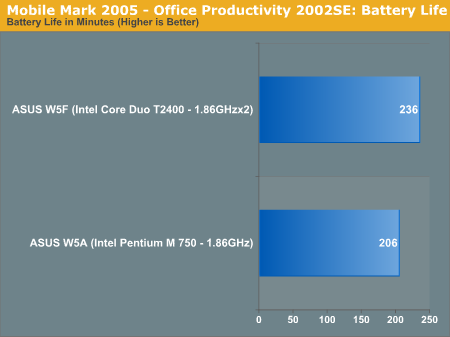
MobileMark 2005's Office Productivity 2002SE test also produces a performance score, to accompany the battery life metric in showing you how fast the notebooks were while on battery power:
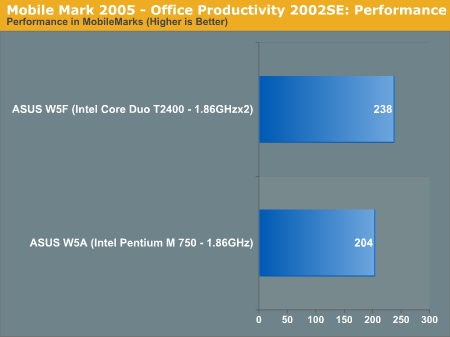
While offering 14.5% longer battery life, the Core Duo notebook also brought us a 16.6% increase in performance. More performance and longer battery life? Who could ask for anything more?
Battery Life - Reading
MobileMark's next battery life test is the Reader 2002SE benchmark, which only provides a battery life metric:
The workload in this category models a notebook user reading a book on his computer.
Netscape Communicator 6.01: The user opens the Netscape browser and loads an HTML version of "War and Peace." The book consists of 17 HTML files (one per chapter), which are 100KB-400KB each, totaling 3.3 MB. Starting from the beginning, the user reads the book on his screen, and then advances to the next page after two minutes. He continues reading and advancing one page per two minutes until the battery of the notebook computer discharges.
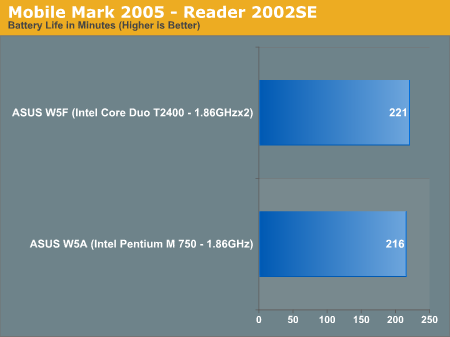
The Reader 2002SE test isn't as strenuous, spending most of its time idle reading through pages, and thus we see a much lower margin of improvement over Dothan. But the important thing to note is that battery life didn't get any worse.
Battery Life - DVD Playback
The DVD Playback 2005 test is just as it seems. This benchmark measures battery life while playing DVD content. The content is provided by BMW:
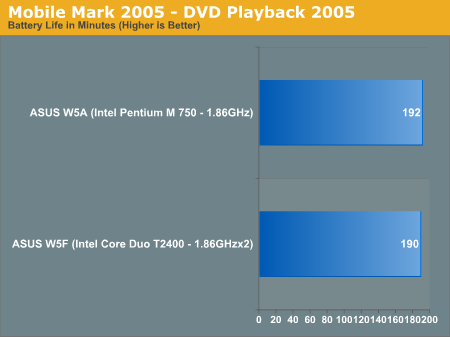
The DVD playback test showed the two notebooks with virtually identical battery lifes. So not all situations will provide you with longer battery life with the Core Duo.
Battery Life - Wireless Web Browsing
Our final battery life test centers around wireless internet browsing; this test requires a web server to wirelessly feed content to the machine being tested, as it browses the web pages stored on the server until it runs out of battery.
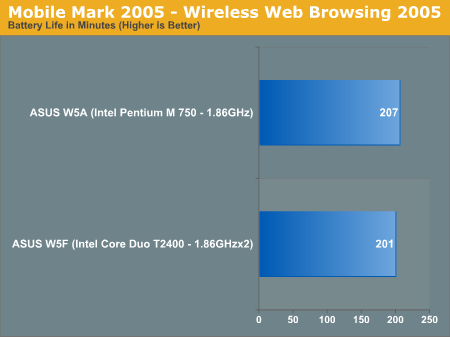
The same situation exists in the wireless browsing test - the two platforms offer virtually identical scores here. The results of this test lead us to believe that there are no tangible improvements in battery life due to the new wireless implementation, the improvements thus appear to be all software based.
Once again we see that battery performance isn't improved, but it did not decrease either. Given the single threaded nature of this test, the second core was most likely sitting completely idle while the first core did all of the work here.
Final Words
It’s tough to argue with the numbers - at worst, Intel’s Centrino Duo platform offers the same battery life as the previous generation Centrino, while outperforming it. But at best, Centrino Duo can not only offer better performance than last year’s notebooks, but also longer battery life.
You really can’t get say anything else - you get better performance, longer battery life and all of this at the same price as last year’s notebooks; Centrino Duo is a no-brainer and it is quite possibly the strongest step into a new year that we have seen from Intel in a very long time.
One thing that is very important to keep in mind is that with the Centrino Duo we finally have all of the benefits of a multiprocessor system now in a notebook. That means all of the performance benefits in multithreaded applications as well as the definite reduction in system response time while multitasking are now available to notebook users. While we were very convinced of the move to dual core on the desktop, it may even make more of an impact on the mobile side. The impact on response time, especially when multitasking, is tremendous and quite perceivable. Notebooks are still quite disk limited, but the impact of going to dual core is big enough to be very noticeable.
Honestly our only complaint is about availability. The launch does not seem to be as well put together as previous Centrino launches, with availability varying dramatically depending on which manufacturer you talk to. The fact that the only production quality notebooks we were able to secure were from ASUS and not from HP, Gateway, Dell or Lenovo tells us that these things aren’t ready just yet. Intel’s Mooly Eden once told us that you should never launch a new microarchitecture along with a new manufacturing process, but with the Core Duo it seems that they may have done just that. We’d tend to believe that the fact that Intel’s 65nm process is just now ramping up is a large part of the reason why we don’t have many Centrino Duo notebooks in house today. However, just about all of the aforementioned manufacturers will be demonstrating their Core Duo notebooks at the show and we’ve already got a couple promised to us after the show, so it does look like you’ll be able to start getting your hands on these things in the relatively near future.
When all is said and done, we can chalk Centrino Duo up to another win for Intel’s Israel team, who is quickly racking up a serious track record over there. While we know that Intel’s next-generation desktop and server micro-architectures will be based off of the work that the Israel team has done with the Pentium M and Core Duo, we can’t help but think that Intel probably should’ve handed them the reins a little earlier.
While we would normally have finished our review on the previous page, we were given the opportunity to preview another Centrino Duo notebook - the IBM/Lenovo Thinkpad T60. The Thinkpad T series has long been a favorite among businesses, on the coming pages you’ll get an early look at the model that will be carrying the torch going forward.
Lenovo Thinkpad T60 Preview
We managed to get our hands on a pre-production version of Lenovo’s upcoming Centrino Duo based Thinkpad T60 in time for this article. The pre-production nature of the laptop obviously meant that we couldn’t rely on it for performance comparisons, but it did give us a nice solution to look forward to from Lenovo.
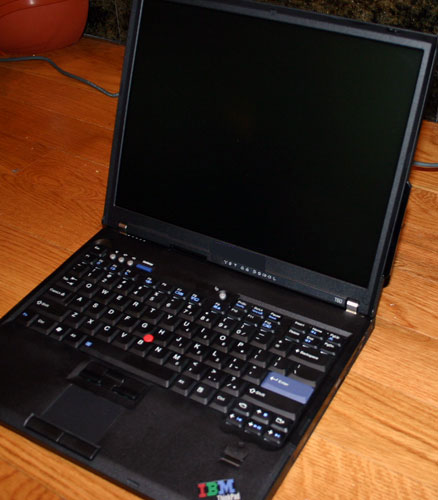
The biggest feature of the Thinkpad T60 is the fact that it is one of Lenovo’s first Centrino Duo capable notebooks. The sample we got was in fact a Centrino Duo system as it was equipped with an Intel 945GM chipset, 3945ABG wireless solution and an Intel Core Duo T2600 (2.16GHz) processor. IBM does offer other versions of the T60 that use the Core Duo processor but don’t meet the requirements to be called a Centrino Duo as well.
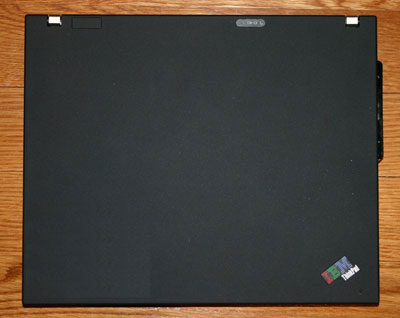
The system we tested was outfitted with 512MB of DDR2-533 memory and an 80GB 5400RPM SATA drive.
Since we didn’t have any previous-generation T series notebooks on hand to compare to, our battery life numbers have to stand alone. We used a standard 6-cell battery with the T60 and it managed to provide us with 300 minutes of battery life during the Mobile Mark 2005 Office Productivity 2002SE test. The Reader 2002SE test yielded a similar battery life of 297 minutes. DVD playback was a bit shorter at 227 minutes but Mobile Mark’s wireless browsing test was back up past the 5 hour mark at 301 minutes.
All in all we saw around 5 hours of battery life in most of the situations we tested in; obviously your mileage will vary depending on the type of usage but we are confident that with the Centrino Duo platform we will finally start seeing more manufacturers break the 5 hour mark for normal usage.
Actual performance of the T60 was a mixed bag, most likely due to its pre-production nature. Its performance in SYSMark 2004 was about where we’d expect it, with an overall score of 210 - making it faster than our desktop Athlon 64 X2 3800+ (with a desktop hard drive). The T60 did fine in the Internet Content Creation tests, scoring a 289 but in the Office Productivity tests it lagged behind pulling in a meager 152. For whatever reason the T60’s performance in the Data Analysis tests was quite poor, which led to its lackluster performance in the OP suite. Once final hardware is ready we will revisit performance, and assuming the performance issues can be taken care of we’d expect a pretty impressive showing from the T60.
Lenovo T60 - The Tangible Intangibles
The construction of the T60 is top notch, as is the case with all Thinkpads. The screen latches onto the rest of the notebook at two points, but the latch is operated by a single lever at the front of the notebook.
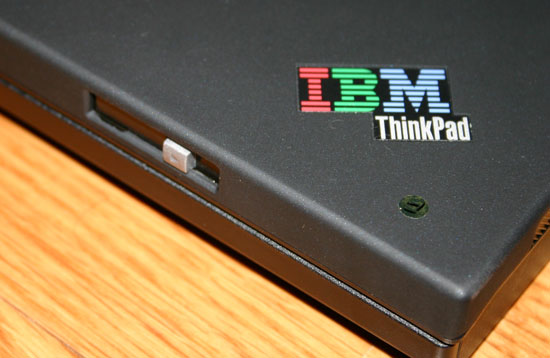
At around 5lbs, the T60 isn’t an ultraportable but it is light enough to carry around while offering the screen real estate to get some serious work done. While the X series is better suited for the constant traveler, the T series is good for the user that needs to get more of a desktop experience while sacrificing a bit of mobility.
On the right side of the notebook you’ve got the Thinkpad UltraBay, which on our sample was outfitted with a DVD-ROM/CD-RW drive. You can replace the DVD drive with an extra battery that will supposedly bring the T60 up to a full 9 hours of battery life. Given what we’ve seen with the standard 6-cell battery, a second battery should have no problems almost doubling the battery life you get out of the box. We’d like to put that claim to the test, but once again we’ll have to wait for final hardware.
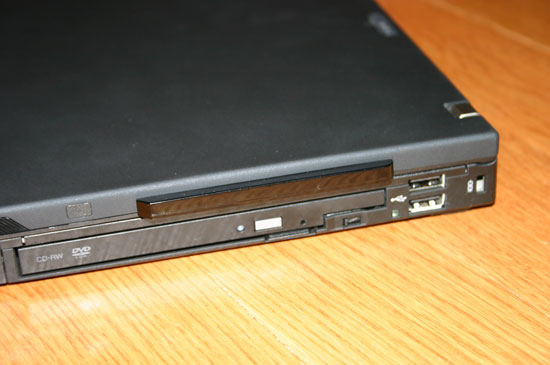
Next to the UltraBay there are two USB 2.0 ports stacked on top of one another.
On the back of the notebook there is the power connector for the AC adapter as well as vents to draw in cool air for the CPU’s heatsink.
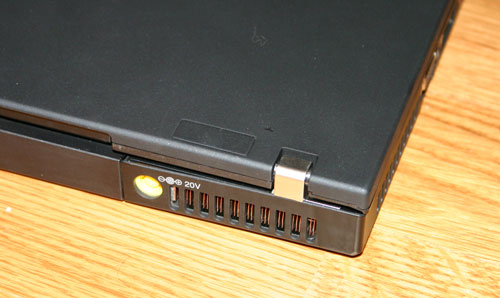
The front of the notebook has an IR port as well as a button to manually disable the wireless adapter. Having the latter is always useful from a battery conservation standpoint, as well as being simply more convenient than trying to disable the wireless adapter in software.
On the left side of the notebook we’ve got some more vents for the CPU’s heatsink/fan, a VGA output, both phone and Ethernet jacks, mic-in and headphone-out, a vertical USB 2.0 port, Express Card slot and a legacy PC Card slot.
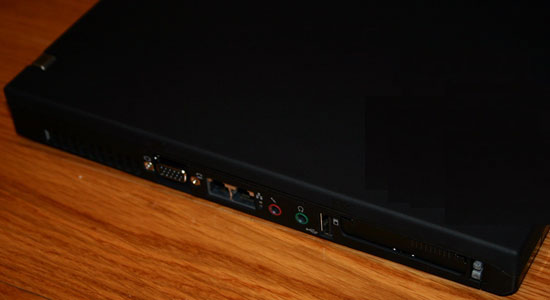
The T60 we reviewed was outfitted with a 14.1” SXGA+ screen with a native resolution of 1400 x 1050. The resolution and screen size are well matched for one another and was quite comfortable to work with, even for long periods of time.
The screen itself features a decent backlight and doesn’t use any high-contrast coating. The maximum setting on the backlight however isn’t the brightest we’ve seen, we would characterize it as about average for a screen of this size. The panel is sufficient for the needs of the T60 but it is by no means stellar.
As a Centrino Duo notebook, the T60 we reviewed relied on the integrated Intel graphics to drive the panel. Intel’s integrated graphics, as you can guess, work just fine for normal day to day tasks but don’t plan on getting any sort of real gaming done on this notebook.
Lenovo T60 - Usability
Moving beyond the specifications and the ports on the T60, we get to honestly one of its biggest selling points - the keyboard. The keyboard on the T60 is absolutely stellar, with tactile feedback and key positioning among the best in the market. Much like the T and X series designs of the past, there is a keyboard light that is accessible using the Fn + PgUp keyboard shortcut. The light is mounted on the frame of the LCD panel and does a decent job of illuminating the keyboard. The effect is better than having an unlit keyboard, however we do prefer Apple’s fiber-optic lighting system if given an option.
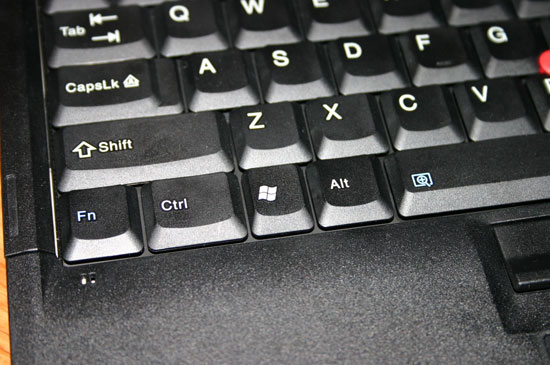
After Lenovo took over the Thinkpads finally got a Windows key, which had been kept off of their designs by IBM as a way of preserving the size and feel of the left CTRL and ALT keys. The inclusion of the Windows key results in a mixed bag of feelings, those who didn’t mind mapping it to another key on older Thinkpads will be displeased while those who sorely missed it will be ecstatic beyond belief. We’re not fond of it, but others may not share our sentiments.
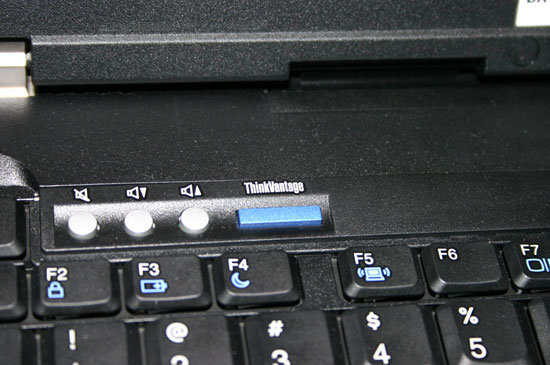
Also in the usual Thinkpad tradition, there’s a blue ThinkVantage button at the top left of the keyboard that will allow you to interrupt the normal startup of the machine and do anything from restore the entire state of the system back to its factory defaults, change boot devices or access the BIOS. While the ThinkVantage button was functional, the necessary software wasn’t present to allow us to test the functionality of the pre-boot loader. We’ll obviously look at ThinkVantage and other similar features once we have final shipping hardware (and software) in our possession.
Given that it uses a 14.1” 4:3 display, Lenovo had a large enough footprint on the T60 to include both a trackpad and TrackPoint on the system. Given how much of a passion users have for one method over the other, including both whenever possible never hurts - especially when you pair it up with an excellent keyboard. The TrackPoint stick is paired with three buttons, the middle which can be held down to turn the pointer into a virtual scroll wheel.

As with previous T series notebooks, the T60 does feature a fingerprint scanner and software that allows you to simply scan your fingerprint instead of having to type in Windows passwords. The supplied software will also manage website passwords for you, once again requiring just a finger swipe instead of remembering and typing in your password. The fingerprint scanner functionality has been on previous Thinkpad notebooks and unfortunately we didn’t have access to the shipping software for this review, so once again we will have to save our evaluation of the technology until a production level notebook is ready.
All in all the Thinkpad T60 was pretty much what we have come to expect from IBM, which is good to know since it is now manufactured by Lenovo. From what we’ve seen, the T60 looks to be just as strong as previous Thinkpad notebooks and now armed with Intel’s Centrino Duo platform, it could very well become one of the notebooks to get in 2006. We’ll reserve final judgment until shipping hardware is available, but so far it is looking promising.

